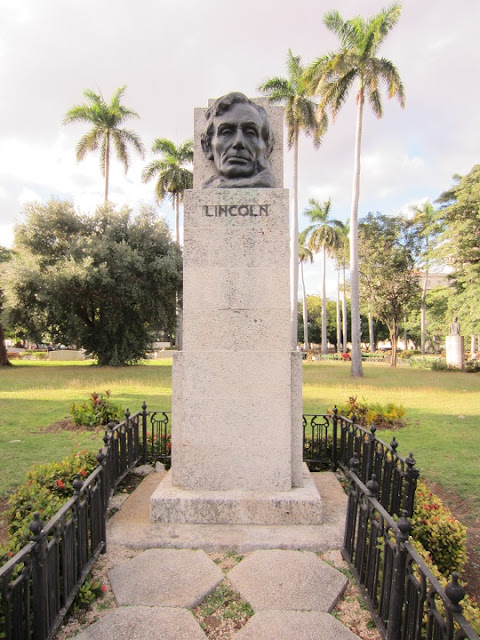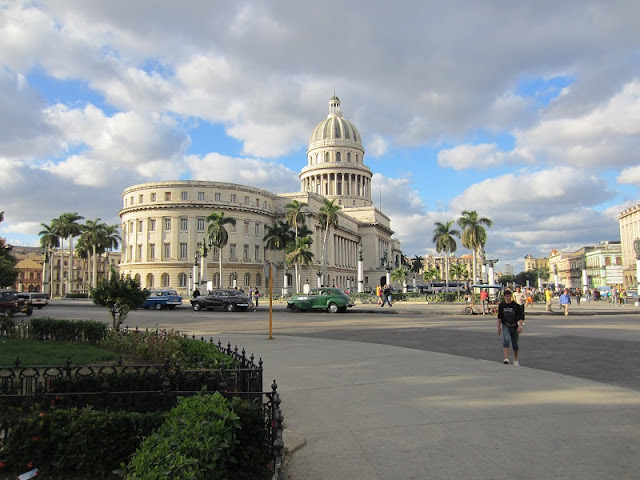Right next to the Capitolio Building in Old Havana is a lovely park called the "Parque de la Fraternidad". It was originally set up in 1892 to be a parade ground for the Capitol Building next to it and to commemorate the "Fourth Centennial" of the Spanish landing in the Americas.
In 1927 the park was changed and renamed what we know it as today to mark the Sixth Pan-American Conference that was being held in Havana the following year. The name was to signify American brotherhood and therefore busts of Latin and North American leaders are scattered all around the park. A Ceiba Tree, considered holy by African slaves, was planted in 1928 using a mixture of soils from all the countries of the Americas as a show of friendship. It sits in the middle of the park encased within an iron gate showing a plaque with the participating countries. The "Fuente de La India", the fountain of the Indian Queen was added in 1931 when it was sculpted by Giuseppe Gaggini and dedicated to the city of Havana. The sculpture is made of marble from Carrara Italy.
The park sits in a very busy part of the city. On one side you have a major bus stop that always seems to be packed with waiting passengers. Another side is lined with an unusual amount of those postcard perfect classic cars. They're all taxis looking for fares and make for some great pictures. On another side you have the Capitolio and on the last side the main street that takes you down to Prado. I've been told by locals that the park turns into a major Gay scene at night. That's pretty much it in a nutshell. It's a pleasant few minute stop if you happen to be in the area. Enjoy the pictures.
Plaque showing the participating Countries
In 1927 the park was changed and renamed what we know it as today to mark the Sixth Pan-American Conference that was being held in Havana the following year. The name was to signify American brotherhood and therefore busts of Latin and North American leaders are scattered all around the park. A Ceiba Tree, considered holy by African slaves, was planted in 1928 using a mixture of soils from all the countries of the Americas as a show of friendship. It sits in the middle of the park encased within an iron gate showing a plaque with the participating countries. The "Fuente de La India", the fountain of the Indian Queen was added in 1931 when it was sculpted by Giuseppe Gaggini and dedicated to the city of Havana. The sculpture is made of marble from Carrara Italy.
The park sits in a very busy part of the city. On one side you have a major bus stop that always seems to be packed with waiting passengers. Another side is lined with an unusual amount of those postcard perfect classic cars. They're all taxis looking for fares and make for some great pictures. On another side you have the Capitolio and on the last side the main street that takes you down to Prado. I've been told by locals that the park turns into a major Gay scene at night. That's pretty much it in a nutshell. It's a pleasant few minute stop if you happen to be in the area. Enjoy the pictures.
The Ceiba Tree
Plaque showing the participating Countries
The Ceiba Tree
Simon Bolivar - Led 4 South American countries to Independence
Ramon Emeterio Betances - father of the Puerto Rican Independence Movement
Joaquin Jose Da Silva Xavier
Led the First Organized Movement against the Portuguese in Brazil
Fuente de La India
Abraham Lincoln - Preserved the Union while ending slavery in the US
Juarez - Was a Strong leader for Mexico when they needed one most
To your left, going North, you go towards the blvd. "Prado" which takes you to the ocean
Jose Bonifacio de Andrada
One of the most Important Mentors of the Brazilian Independence
The One side of the Park with the street lined with Classic Old Cars working as Taxis



















































